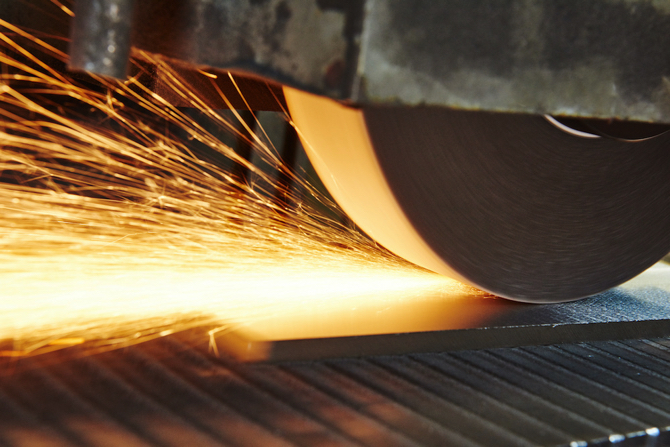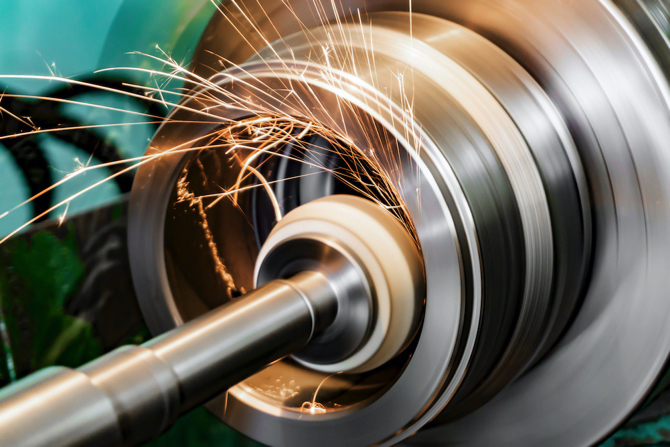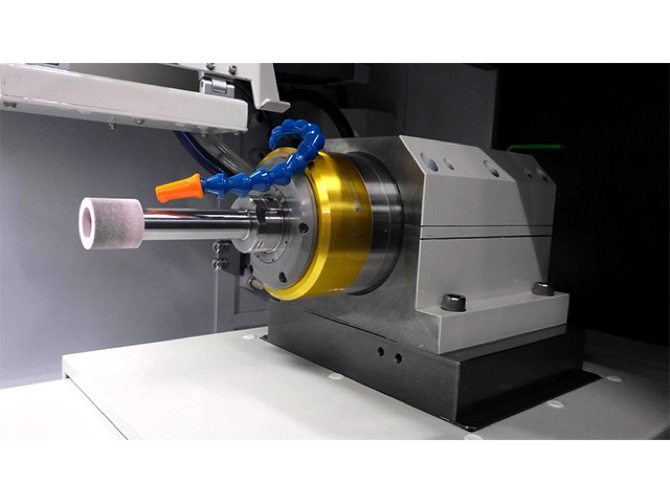- ホーム
- 精機部:コラム【英語】
- Griding machine
Griding machine
Grinding is a part of cutting and is one of the indispensable processing methods when processing materials with high accuracy. Equipment that performs grinding is called a grinder or a grinding machine.
In this article, we explain in detail the types of grinders and grinding processes, and introduce the features of Seiko Instruments' internal grinders.

What is a grinder?
A grinder is a facility that processes a workpiece by pressing a grindstone that rotates at high speed against the material to be processed. Since the surface is scraped little by little, it takes longer to achieve the desired shape compared to cutting. However, since it is scraped slowly and little by little, high accuracy can be achieved.
Since it takes time to process, it is not suitable to process the workpiece from the state of the material only with a grinder. It is generally used in the finishing process to improve the surface accuracy after shaping the workpiece to the desired shape by cutting.
It is also widely used in addition to finishing, such as processing materials called difficult-to-cut materials that are difficult to process by cutting and deburring forged products.
Grinders mainly include free grinders and mechanical grinders. Free grinders are often called grinders, and because of their small size, they are used to process materials by hand. Mechanical grinders are large equipment and are mainly used by installing them in factories such as the manufacturing industry.
In this article, we will mainly explain about mechanical grinders.
Types of grinders
Mechanical grinders can be classified according to the purpose of machining and the shape to be machined. We explain five typical types.
1.Surface grinder
A processing method that grinds the surface of a workpiece using a rotary grindstone is called surface grinding. With surface grinding, it is possible to achieve both high dimensional accuracy and high-precision surface roughness, not only to adjust the thickness of the workpiece, but also to achieve high flatness and parallelism on both sides of the workpiece.
It consists of a table for fixing the workpiece and a grindstone shaft. The table can be classified into a square table and a circular table, and the grindstone shaft can be classified into vertical and horizontal types and vertical and horizontal composites.
Each combination affects the shape and productivity of the work piece that can be handled and the accuracy during processing.

2.Internal griding machine
Internal surface grinding is a processing method that grinds the inner surface of a cylindrical workpiece. There is honing as a processing method for finishing the inner surface, but unlike honing processing, internal grinding does not depend much on the state of pre-machining.
Equipment that performs internal grinding is called an internal grinder or an internal grinding machine, and can be mainly classified into ordinary type and planetary type.
The ordinary grinder can achieve high accuracy by traversing the grindstone while rotating both the workpiece and the grindstone.
On the other hand, the planetary type internal grinder rotates only the grindstone with the workpiece fixed. The processing accuracy is inferior to that of the ordinary type, but it is used properly according to the application because it can handle unstable shapes other than large workpieces and round objects that are difficult to handle with the ordinary type.
In addition, the internal grinder can grind not only one surface but also multiple surfaces, tapered surfaces, and end surfaces.
3.Cylindrical grinder
The processing method of grinding the outer part of a cylindrical workpiece is called cylindrical grinding. It is a method of processing by pressing a rotated grindstone against a rotated cylindrical workpiece, and it is known that the processing accuracy is higher than that of lathe processing and milling machine processing.
Cylindrical grinding is classified into traverse grinding, plunge grinding, and angular grinding. Traverse grinding moves the grindstone in parallel with the axial direction of the workpiece, and plunge grinding moves the grindstone or the workpiece in the radial direction of the grindstone. In angular grinding, a coma-shaped grindstone is pressed against the axis of the workpiece at a fixed angle.
These grinds are performed using cylindrical grinders or universal grinders.
4.Centerless grinder
The method of grinding by supporting the workpiece with an adjusting wheel, a grinding wheel, and a support blade is called centerless grinding.
Like cylindrical grinding, it is suitable for cylindrical workpieces, and can be mass-produced by combining it with an automatic parts supply device.
Another advantage is that the grinding accuracy for the workpiece can be kept constant because centering is not required.
5.Tool grinder
Using a polishing tool or a grinding wheel to make a cutting tool or re-grinding to improve sharpness is called tool grinding. There are various materials and shapes of cutting tools depending on the purpose, and it is necessary to change the mounting method according to the tool you want to grind.
The equipment that grinds tools is a tool grinder or a tool grinding machine, and it is classified by the name of grindable tools such as tool grinders, drill grinders, and cutter grinders according to the type of tool to be ground.
High-precision, high-efficiency and space-saving grinders are desired.
There are different types of grinding machines in the fields. In recent years, precision equipments have become more complicated and smaller, and their components are also required to be small and highly accurate. Therefore, the grinding machine that processes them is also required to have high accuracy and efficiency. It is also necessary to reduce the equipment installation area without degrading performance from the viewpoint of environment and space efficiency.
Internal grinders are being developed to meet these demands, but you may be worried that the usage will change when you introduce new grinders.
Even if you have anxiety, we have a lot of support from before the introduction to after the introduction, so we can get immediately respond to your consultation and eliminate the anxiety.

Seiko Instruments’ Internal grinder
Seiko Instruments' internal grinder is equipped in-house developed high-frequency spindles, which achieves high accuracy, work efficiency, and space saving, especially for small-diameter hole grinding.
The product is developed based on the technical philosophy of "SYO" ism (high performance, minimal cost, environmentally friendly and user friendly). And the know-how that has supported the production of wristwatches for many years is utilized in the internal grinder
Summary
Grinders are mainly used for finishing and machining difficult-to-cut materials, but various equipment and machining methods are used depending on the workpiece and shape. In addition, the demand for processing equipment continues to increase due to the miniaturization and complexity of finished products.
Seiko Instruments develops, manufactures, and sells internal grinder that achieve high precision by adopting a high-frequency spindle developed in-house and space saving. The support system is also substantial. If you are considering the introduction of internal grinder, please contact Seiko Instruments once.

